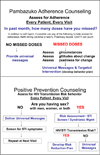An integrated approach for antiretroviral adherence and secondary HIV transmission risk-reduction support by nurses in Kenya
- PMID: 21803605
- PMCID: PMC4018811
- DOI: 10.1016/j.jana.2011.05.001
An integrated approach for antiretroviral adherence and secondary HIV transmission risk-reduction support by nurses in Kenya
Abstract
Ongoing antiretroviral therapy (ART) adherence and secondary HIV transmission-risk reduction (positive prevention) support are needed in resource-limited settings. We evaluated a nurse-delivered counseling intervention in Kenya. We trained 90 nurses on a brief counseling algorithm that comprised ART and sexual-risk assessment, risk-reduction messages, and health-promotion planning. Self-reported measures were assessed before, immediately after, and 2 months post-training. Consistent ART adherence assessment was reported by 29% of nurses at baseline and 66% at 2 months post-training (p < .001). Assessment of patient sexual behaviors was 25% at baseline and 60% at 2 months post-training (p < .001). Nurse practice behaviors recommended in the counseling algorithm improved significantly at 2 months post-training compared with baseline, odds ratios 4.30-10.50. We found that training nurses in clinical counseling for ART adherence and positive prevention is feasible. Future studies should test impact of nurse counseling on patient outcomes in resource-limited settings.
Copyright © 2012 Association of Nurses in AIDS Care. Published by Elsevier Inc. All rights reserved.
Conflict of interest statement
The authors report no real or perceived vested interests that relate to this article (including relationships with pharmaceutical companies, biomedical device manufacturers, grantors, or other entities whose products or services are related to topics covered in this manuscript) that could be construed as a conflict of interest.
Figures


Similar articles
-
Computer-Based Counseling Program (CARE+ Kenya) to Promote Prevention and HIV Health for People Living With HIV/AIDS: A Randomized Controlled Trial.AIDS Educ Prev. 2019 Oct;31(5):395-406. doi: 10.1521/aeap.2019.31.5.395. AIDS Educ Prev. 2019. PMID: 31550197 Free PMC article. Clinical Trial.
-
A Pilot Randomized Controlled Trial of an Integrated In-person and Mobile Phone Delivered Counseling and Text Messaging Intervention to Reduce HIV Transmission Risk among Male Sex Workers in Chennai, India.AIDS Behav. 2017 Nov;21(11):3172-3181. doi: 10.1007/s10461-017-1884-5. AIDS Behav. 2017. PMID: 28831618 Free PMC article. Clinical Trial.
-
Counseling Framework for HIV-Serodiscordant Couples on the Integrated Use of Antiretroviral Therapy and Pre-exposure Prophylaxis for HIV Prevention.J Acquir Immune Defic Syndr. 2017 Jan 1;74 Suppl 1(Suppl 1):S15-S22. doi: 10.1097/QAI.0000000000001210. J Acquir Immune Defic Syndr. 2017. PMID: 27930607 Free PMC article.
-
Motivating HIV positive women to adhere to antiretroviral therapy and risk reduction behavior: the KHARMA Project.Online J Issues Nurs. 2006 Jan 31;11(1):5. Online J Issues Nurs. 2006. PMID: 16629499 Review.
-
A Systematic Review of Nurse-Led Antiretroviral Medication Adherence Intervention Trials: How Nurses Have Advanced the Science.J Assoc Nurses AIDS Care. 2021 May-Jun 01;32(3):347-372. doi: 10.1097/JNC.0000000000000247. J Assoc Nurses AIDS Care. 2021. PMID: 33883529
Cited by
-
Pre/post evaluation of a pilot prevention with positives training program for healthcare providers in North West Province, Republic of South Africa.BMC Health Serv Res. 2017 May 2;17(1):316. doi: 10.1186/s12913-017-2263-7. BMC Health Serv Res. 2017. PMID: 28464926 Free PMC article.
-
A role for health communication in the continuum of HIV care, treatment, and prevention.J Acquir Immune Defic Syndr. 2014 Aug 15;66 Suppl 3(0 3):S306-10. doi: 10.1097/QAI.0000000000000239. J Acquir Immune Defic Syndr. 2014. PMID: 25007201 Free PMC article.
-
Noncompliance in people living with HIV: accuracy of defining characteristics of the nursing diagnosis1.Rev Lat Am Enfermagem. 2017 Oct 30;25:e2940. doi: 10.1590/1518-8345.1582.2940. Rev Lat Am Enfermagem. 2017. PMID: 29091125 Free PMC article.
-
Evidence and gap map report: Social and Behavior Change Communication (SBCC) interventions for strengthening HIV prevention and research among adolescent girls and young women (AGYW) in low- and middle-income countries (LMICs).Campbell Syst Rev. 2023 Jan 10;19(1):e1297. doi: 10.1002/cl2.1297. eCollection 2023 Mar. Campbell Syst Rev. 2023. PMID: 36911864 Free PMC article.
-
HIV sexual transmission risks in the context of clinical care: a prospective study of behavioural correlates of HIV suppression in a community sample, Atlanta, GA, USA.J Int AIDS Soc. 2015 Aug 5;18(1):19930. doi: 10.7448/IAS.18.1.19930. eCollection 2015. J Int AIDS Soc. 2015. PMID: 26249127 Free PMC article.
References
-
- Amico KR, Harman JJ, Johnson BT. Efficacy of antiretroviral therapy adherence interventions: A research synthesis of trials, 1996 to 2004. Journal of Acquired {mmune Deficiency Syndromes. 2006;41(3):285–297. - PubMed
-
- Bunnell R, Ekwaru JP, Solberg P, Wamai N, Bikaako-Kajura W, Were W, Mermin J. Changes in sexual behavior and risk of HIV transmission after antiretroviral therapy and prevention interventions in rural Uganda. AIDS. 2006;20(1):85–92. - PubMed
-
- Bunnell RE, Nassozi J, Marum E, Mubangizi J, Malamba S, Dillon B, Mermin JH. Living with discordance: Knowledge, challenges, and prevention strategies of HIV-discordant couples in Uganda. AIDS Care. 2005;17(8):999–1012. - PubMed
-
- Carney PA, Ward DH. Using unannounced standardized patients to assess the HIV preventive practices of family nurse practitioners and family physicians. The Nurse Practitioner. 1998;23(2):56–58. 63, 67–58. - PubMed
-
- Centers for Disease Control and Prevention, Health Resources and Services Administration, National Institutes of Health, HIV Medicine Association of the Infectious Society of America, HIV Prevention in Clinical Care Working Group. Recommendations for incorporating human immunodeficiency virus (HIV) prevention into the medical care of persons living with HIV. Clinical Infectious Diseases. 2004;38(1):104–121. - PubMed
Publication types
MeSH terms
Grants and funding
LinkOut - more resources
Full Text Sources
Medical

